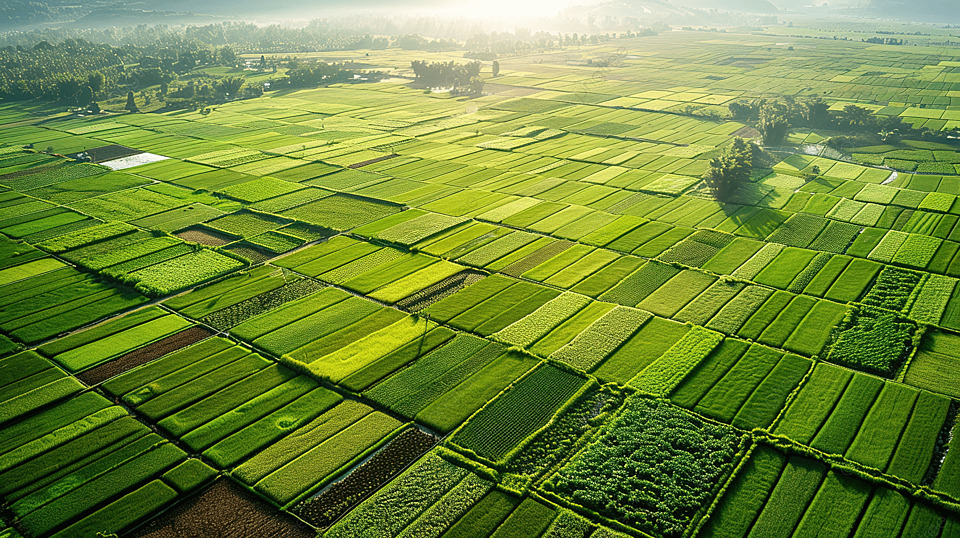
When dealing with land measurements, understanding the various units and their conversions is crucial. Among these, the square meter (m²) and the hectare (ha) are commonly used units, especially in real estate and agriculture. This article will explore the definitions, usage, and conversion between square meters and hectares.
Understanding Square Meters and Hectares
Square Meter (m²)
A square meter is a unit of area measurement in the metric system, defined as the area of a square with sides that are one meter long. This unit is widely used across the world for measuring smaller plots of land, rooms, or any other area where precise measurements are required.
- Symbol: m²
- Usage: The square meter is commonly used in construction, interior design, land measurement, and more. For example, when measuring the floor area of a house, the dimensions of a garden, or the size of a room, the square meter is the standard unit of measurement.
Hectare (ha)
A hectare is a larger unit of area measurement in the metric system, commonly used for measuring larger plots of land, such as agricultural fields, forests, and large estates. One hectare is equivalent to 10,000 square meters.
- Symbol: ha
- Usage: The hectare is predominantly used in agriculture, forestry, and land management. When discussing the size of farms, forests, or large plots of land, the hectare is the preferred unit due to its suitability for expressing large areas.
Conversion Between Square Meters and Hectares
Understanding the conversion between Square Meter to Hectare is essential for professionals in real estate, agriculture, and land management. The conversion is straightforward:
1 hectare (ha) = 10,000 square meters (m²)
To convert from square meters to hectares, divide the number of square meters by 10,000. Conversely, to convert from hectares to square meters, multiply the number of hectares by 10,000.
Examples of Conversions
Example 1: Converting Square Meters to Hectares
Suppose you have a plot of land measuring 25,000 square meters, and you want to convert this measurement into hectares.
Hectares=Square Meters10,000\text{Hectares} = \frac{\text{Square Meters}}{10,000}Hectares=10,000Square Meters
Hectares=25,000 m210,000\text{Hectares} = \frac{25,000 \, \text{m}²}{10,000}Hectares=10,00025,000m2
Hectares=2.5 ha\text{Hectares} = 2.5 \, \text{ha}Hectares=2.5ha
Therefore, 25,000 square meters is equal to 2.5 hectares.
Example 2: Converting Hectares to Square Meters
Suppose you have a farm that is 3 hectares in size, and you want to know the area in square meters.
Square Meters=Hectares×10,000\text{Square Meters} = \text{Hectares} \times 10,000Square Meters=Hectares×10,000
Square Meters=3 ha×10,000\text{Square Meters} = 3 \, \text{ha} \times 10,000Square Meters=3ha×10,000
Square Meters=30,000 m2\text{Square Meters} = 30,000 \, \text{m}²Square Meters=30,000m2
Therefore, 3 hectares is equal to 30,000 square meters.
Practical Applications of the Conversion
Real Estate
In real estate, accurate measurement and representation of property sizes are crucial for valuation, planning, and development. Understanding the conversion between square meters and hectares helps real estate professionals provide precise information to clients.
For instance, when listing a property for sale, knowing the area in both square meters and hectares can cater to different buyer preferences. Some clients might be more familiar with hectares, especially in rural or agricultural contexts, while others may prefer square meters for urban properties.
Agriculture
In agriculture, land measurement is vital for planning crop rotation, irrigation, and resource allocation. Farmers and agronomists use hectares to describe large fields and farmlands, making it easier to manage and communicate the scale of agricultural operations.
For example, if a farmer is planning to plant a specific crop on a 50-hectare field, they can easily convert this measurement to square meters (500,000 m²) to determine the amount of seed, fertilizer, and other inputs required for the entire area.
Urban Planning
Urban planners and civil engineers often work with both Square Meter Converter and hectares when designing cities, parks, and infrastructure projects. Understanding the conversion between these units ensures accurate area calculations for zoning, land use, and development projects.
For instance, when designing a new park, urban planners might initially use hectares to outline the total area. However, for detailed planning, including pathways, playgrounds, and facilities, they would switch to square meters to ensure precision.
Tools and Resources for Conversion
While the manual conversion between square meters and hectares is simple, several tools and resources can assist in making these calculations even easier:
Online Conversion Tools
Numerous online calculators are available that can quickly convert between square meters and hectares. These tools are user-friendly and can handle large numbers, making them ideal for professionals who need quick and accurate conversions.
Mobile Apps
Several mobile apps offer area conversion features, allowing users to convert measurements on the go. These apps often include additional functionalities, such as converting between other units of area, volume, and length.
Spreadsheets
For those who frequently work with area measurements, creating a spreadsheet with built-in conversion formulas can be a practical solution. This approach allows for quick conversions and the ability to handle large datasets efficiently.
Conclusion
Understanding the conversion between square meters and hectares is essential for professionals in real estate, agriculture, and urban planning. The straightforward conversion formula makes it easy to switch between these units, ensuring accurate area measurements Land Area Converter, for various applications.
Whether you’re a real estate agent listing properties, a farmer planning crop rotations, or an urban planner designing city infrastructure, mastering this conversion will enhance your ability to communicate and manage land measurements effectively. Utilizing tools such as online calculators, mobile apps, and spreadsheets can further streamline the process, ensuring precision and efficiency in your work.